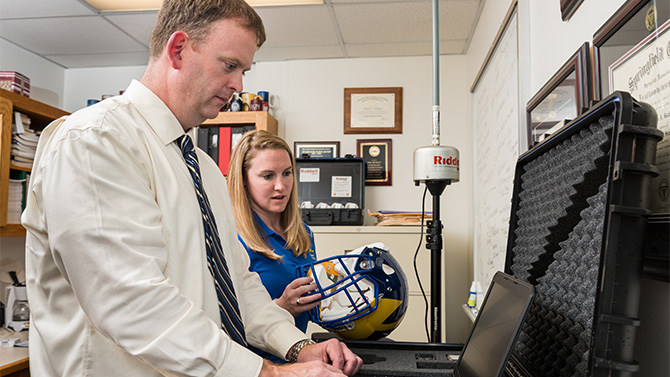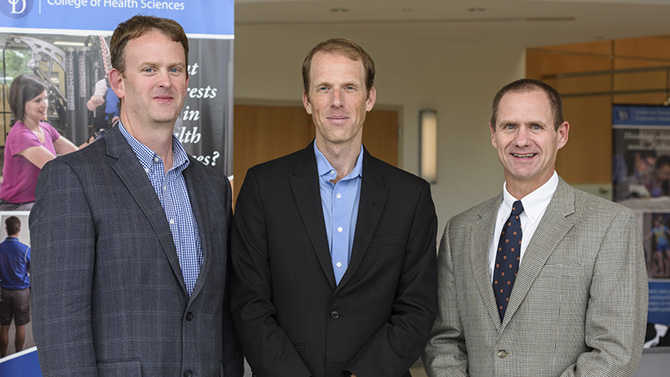

National concussion study
Photos by Evan Krape and Kathy F. Atkinson April 20, 2017
UD researchers play key role in largest concussion project ever conducted
The University of Delaware is working on the largest research concussion study ever conducted. The NCAA/Department of Defense Grand Alliance CARE Consortium is tasked with a national, longitudinal study to address the fundamental question, “What is the natural history of a concussion?”
UD’s research team, led by Thomas Buckley and Tom Kaminski, both of the Department Kinesiology and Applied Physiology in the College of Health Sciences, is one of the 30 research institutions working on the massive project.
With an eye to the future, this project will determine concussion management policies and clinical practices.
Nationally, more than 23,000 student-athletes and military service academy students around the country are enrolled. The CARE Consortium recently published its first paper, “A National Study on the Effects of Concussion in Collegiate Athletes and U.S. Military Service Academy Members.” The article details the consortium’s objectives and methods.
“Part of the value of the methods paper is that it lays out what we’re doing, but it can also help inform clinical practice,” explained Buckley, an assistant professor. “Now people at high schools and colleges not involved in the project are able to see best practices are for concussion management.”
The information gives schools with limited resources a guide to appropriately manage concussions. Some of these current practices include very expensive tests like neuroimaging, blood draws or helmet impact telemetries.
“The good news is that you don’t always need expensive tests,” he said. “The paper lays out the clinical testing that any athletic training or sports medicine program can do — whether it be balance testing, cognitive testing, vision testing or reaction time.”
Of the aforementioned 23,000 participants enrolled nationwide, researchers are assessing 2,000 people with concussions. In the not-so-old-days, a paper with information on 25 concussions was considered good.
The immense project puts UD is at the center of the conversation. Now in its second year, UD is deeply engrained, contributing information on 1,200 Blue Hen athletes and approximately 75 concussions. And Buckley and Kaminski are quick to credit UD Athletics for its support in pulling off this study with every single sports team.
“The cooperation of [head athletic trainer] Dan Watson, [head team physician] Andrew Reisman and [athletic director] Chrissi Rawak has been vitally important to the success of this project,” Tom Kaminski, professor and director of UD’s heralded athletic training program. “We couldn’t have better partners.”
What’s next from CARE Consortium?
So what can be expected next from the CARE Consortium? The group will publish the initial data on post-concussion work. Researchers are looking forward to identifying which tests (or series of tests) are the most accurate for concussion management.
“On a large scale, this study will address a lot of questions on concussions that we really don’t have the answer to yet,” said Buckley. “Right now, baseline testing is very commonplace, extremely time-consuming and personnel intensive. Currently, we don’t know what the most valuable test battery is.”
Lots of questions remain unanswered, including:
• What predicts how these tests perform?
• What’s the impact of prior concussions? Of gender?
• Is it possible to identify people who are at higher risk for poor recovery?
Answering these types of questions will allow health professionals to properly respond following a concussion and eliminate ineffective or, in some cases, detrimental treatments.
“It used to be thought that the best treatment for a concussion was to send the person to go sit in a dark room. We are now quite convinced that’s about the worst thing that you can do, yet people are still doing it,” lamented Buckley. “Some quiet time followed an injury is probably warranted, but it’s not a black and white dichotomy — dark room or play football; there is a large gray area between those two things. Getting people back into society and engaged is probably good for recovery. A lot of what happens [in the CARE Consortium study] is going to help us address these issues.”
Contact Us
Have a UDaily story idea?
Contact us at ocm@udel.edu
Members of the press
Contact us at 302-831-NEWS or visit the Media Relations website



